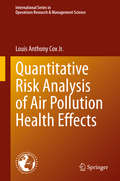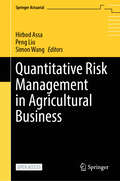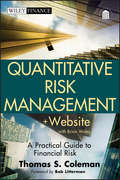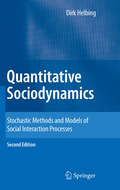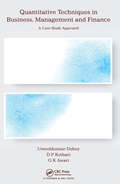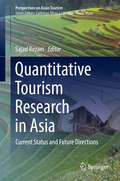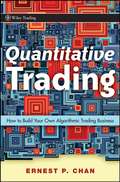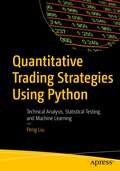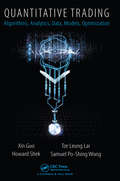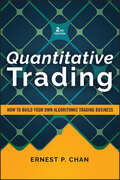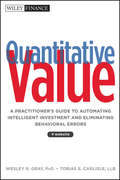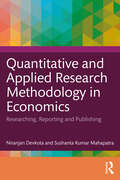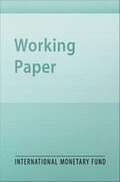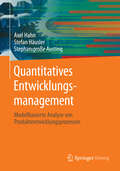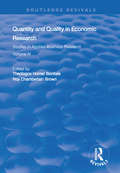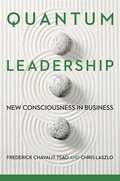- Table View
- List View
Quantitative Risk Analysis of Air Pollution Health Effects (International Series in Operations Research & Management Science #299)
by Louis Anthony Cox Jr.This book highlights quantitative risk assessment and modeling methods for assessing health risks caused by air pollution, as well as characterizing and communicating remaining uncertainties. It shows how to apply modern data science, artificial intelligence and machine learning, causal analytics, mathematical modeling, and risk analysis to better quantify human health risks caused by environmental and occupational exposures to air pollutants. The adverse health effects that are caused by air pollution, and preventable by reducing it, instead of merely being statistically associated with exposure to air pollution (and with other many conditions, from cold weather to low income) have proved to be difficult to quantify with high precision and confidence, largely because correlation is not causation. This book shows how to use recent advances in causal analytics and risk analysis to determine more accurately how reducing exposures affects human health risks. Quantitative Risk Analysis of Air Pollution Health Effects is divided into three parts. Part I focuses mainly on quantitative simulation modelling of biological responses to exposures and resulting health risks. It considers occupational risks from asbestos and crystalline silica as examples, showing how dynamic simulation models can provide insights into more effective policies for protecting worker health. Part II examines limitations of regression models and the potential to instead apply machine learning, causal analysis, and Bayesian network learning methods for more accurate quantitative risk assessment, with applications to occupational risks from inhalation exposures. Finally, Part III examines applications to public health risks from air pollution, especially fine particulate matter (PM2.5) air pollution. The book applies freely available browser analytics software and data sets that allow readers to download data and carry out many of the analyses described, in addition to applying the techniques discussed to their own data.http://cox-associates.com:8899/
Quantitative Risk Management in Agricultural Business (Springer Actuarial)
by Peng Liu Hirbod Assa Simon WangThis open access volume explores the cutting edge of quantitative methods in agricultural risk management and insurance. Composed of insightful articles authored by field experts, focusing on innovation, recent advancements, and the use of technology and data sciences, it bridges the gap between theory and practice through empirical studies, concrete examples and case analyses. Evolving challenges in risk management have called for the development of new, groundbreaking models. Beyond presenting the theoretical foundations of these models, this book discusses their real-world applications, providing tangible insights into how innovative modeling can elevate risk management strategies in the agricultural sector. The latest risk management tools incorporate novel concepts such as index insurance, price index risk management frameworks and risk pools. The practical implications of these approaches are investigated, and their impact on contemporary agricultural risk mitigation and insurance practices is examined. Field experiences illustrate the implementation of these tools and their resulting outcomes. Modern data analysis techniques in agricultural risk and insurance include machine learning, spatial analysis, text analysis, and deep learning. In addition to scrutinizing these ideas, the authors introduce an economic perspective towards risk, highlighting areas that have developed thanks to technological progress. Examples illustrate how these combined methodologies contribute to informed decision-making in agriculture, and their potential benefits and challenges are considered. This carefully compiled volume will be a valuable reference for researchers, practitioners, and students intrigued by the dynamic intersection of agricultural risk management and insurance practices.
Quantitative Risk Management: A Practical Guide to Financial Risk (Wiley Finance #669)
by Thomas S. ColemanState of the art risk management techniques and practices—supplemented with interactive analytics All too often risk management books focus on risk measurement details without taking a broader view. Quantitative Risk Management delivers a synthesis of common sense management together with the cutting-edge tools of modern theory. This book presents a road map for tactical and strategic decision making designed to control risk and capitalize on opportunities. Most provocatively it challenges the conventional wisdom that "risk management" is or ever should be delegated to a separate department. Good managers have always known that managing risk is central to a financial firm and must be the responsibility of anyone who contributes to the profit of the firm. A guide to risk management for financial firms and managers in the post-crisis world, Quantitative Risk Management updates the techniques and tools used to measure and monitor risk. These are often mathematical and specialized, but the ideas are simple. The book starts with how we think about risk and uncertainty, then turns to a practical explanation of how risk is measured in today's complex financial markets. Covers everything from risk measures, probability, and regulatory issues to portfolio risk analytics and reporting Includes interactive graphs and computer code for portfolio risk and analytics Explains why tactical and strategic decisions must be made at every level of the firm and portfolio Providing the models, tools, and techniques firms need to build the best risk management practices, Quantitative Risk Management is an essential volume from an experienced manager and quantitative analyst.
Quantitative Sociodynamics
by Dirk HelbingThis new edition of Quantitative Sociodynamics presents a general strategy for interdisciplinary model building and its application to a quantitative description of behavioral changes based on social interaction processes. Originally, the crucial methods for the modeling of complex systems (stochastic methods and nonlinear dynamics) were developed in physics and mathematics, but they have very often proven their explanatory power in chemistry, biology, economics and the social sciences as well. Quantitative Sociodynamics provides a unified and comprehensive overview of the different stochastic methods, their interrelations and properties. In addition, it introduces important concepts from nonlinear dynamics (e.g. synergetics, chaos theory). The applicability of these fascinating concepts to social phenomena is carefully discussed. By incorporating decision-theoretical approaches, a fundamental dynamic model is obtained, which opens new perspectives in the social sciences. It includes many established models as special cases, e.g. the logistic equation, the gravity model, some diffusion models, evolutionary game theory and social field theory. Moreover, it implies numerous new results and is relevant for various application areas, such as opinion formation, migration, the self-organization of behavioral conventions, and the behavior of customers and voters. Theoretical results are complemented and illustrated by numerous computer simulations. Quantitative Sociodynamics is relevant both for social scientists and natural scientists who are interested in the application of stochastic and synergetics concepts to interdisciplinary topics.
Quantitative Techniques for Competition and Antitrust Analysis
by Peter Davis Eliana GarcésThis book combines practical guidance and theoretical background for analysts using empirical techniques in competition and antitrust investigations. Peter Davis and Eliana Garcés show how to integrate empirical methods, economic theory, and broad evidence about industry in order to provide high-quality, robust empirical work that is tailored to the nature and quality of data available and that can withstand expert and judicial scrutiny. Davis and Garcés describe the toolbox of empirical techniques currently available, explain how to establish the weight of pieces of empirical work, and make some new theoretical contributions. The book consistently evaluates empirical techniques in light of the challenge faced by competition analysts and academics--to provide evidence that can stand up to the review of experts and judges. The book's integrated approach will help analysts clarify the assumptions underlying pieces of empirical work, evaluate those assumptions in light of industry knowledge, and guide future work aimed at understanding whether the assumptions are valid. Throughout, Davis and Garcés work to expand the common ground between practitioners and academics.
Quantitative Techniques in Business, Management and Finance: A Case-Study Approach
by D P Kothari Umeshkumar Dubey G K AwariThis book is especially relevant to undergraduates, postgraduates and researchers studying quantitative techniques as part of business, management and finance. It is an interdisciplinary book that covers all major topics involved at the interface between business and management on the one hand and mathematics and statistics on the other. Managers and others in industry and commerce who wish to obtain a working knowledge of quantitative techniques will also find this book useful.
Quantitative Tourism Industry Analysis
by Tadayuki HaraQuantitative Tourism Industry Analysis is the first book to deal with the input-output, social accounting matrix in a way which readers from a non-economics or non-mathematical background can follow, in order to understand how useful their application would be for tourism industry analysis. It acquaints readers with useful applications of economic modelling without the unnecessary burden of higher algebra, so that they will understand concepts of the economics measurement system, Tourism Satellite Accounts (TSA) methodology.Quantitative Tourism Industry Analysis offers a new set of economic tools for tourism policy analysis, ideal for those with a non-mathematical background.
Quantitative Tourism Research in Asia: Current Status And Future Directions (Perspectives on Asian Tourism)
by Sajad RezaeiThe purpose of this book is twofold. First, this book is an attempt to map the state of quantitative research in Asian tourism and hospitality context and provide a detailed description of the design, implementation, application, and challenges of quantitative methods in tourism in Asia. Second, this book aims to contribute to the tourism literature by discussing the past, current and future quantitative data analysis methods.The book offers new insights into well-established research techniques such as regression analysis, but goes beyond first generation data analysis techniques to introduce methods seldom – if ever – used in tourism and hospitality research. In addition to investigating existing and novel research techniques, the book suggests areas for future studies. In order to achieve its objectives the analysis is split into three main sections: understanding the tourism industry in Asia; the current status of quantitative data analysis; and future directions for Asian tourism research.
Quantitative Trading
by Ernie ChanWhile institutional traders continue to implement quantitative (or algorithmic) trading, many independent traders have wondered if they can still challenge powerful industry professionals at their own game? The answer is "yes," and in Quantitative Trading, Dr. Ernest Chan, a respected independent trader and consultant, will show you how. Whether you're an independent "retail" trader looking to start your own quantitative trading business or an individual who aspires to work as a quantitative trader at a major financial institution, this practical guide contains the information you need to succeed.
Quantitative Trading Strategies Using Python: Technical Analysis, Statistical Testing, and Machine Learning
by Peng LiuBuild and implement trading strategies using Python. This book will introduce you to the fundamental concepts of quantitative trading and shows how to use Python and popular libraries to build trading models and strategies from scratch. It covers practical trading strategies coupled with step-by-step implementations that touch upon a wide range of topics, including data analysis and visualization, algorithmic trading, backtesting, risk management, optimization, and machine learning, all coupled with practical examples in Python.Part one of Quantitative Trading Strategies with Python covers the fundamentals of trading strategies, including an introduction to quantitative trading, the electronic market, risk and return, and forward and futures contracts. Part two introduces common trading strategies, including trend-following, momentum trading, and evaluation process via backtesting. Part three covers more advanced topics, including statistical arbitrage using hypothesis testing, optimizing trading parameters using Bayesian optimization, and generating trading signals using a machine learning approach. Whether you're an experienced trader looking to automate your trading strategies or a beginner interested in learning quantitative trading, this book will be a valuable resource. Written in a clear and concise style that makes complex topics easy to understand, and chock full of examples and exercises to help reinforce the key concepts, you’ll come away from it with a firm understanding of core trading strategies and how to use Python to implement them.What You Will LearnMaster the fundamental concepts of quantitative tradingUse Python and its popular libraries to build trading models and strategies from scratchPerform data analysis and visualization, algorithmic trading, backtesting, risk management, optimization, and machine learning for trading strategies using PythonUtilize common trading strategies such as trend-following, momentum trading, and pairs tradingEvaluate different quantitative trading strategies by applying the relevant performance measures and statistics in a scientific manner during backtestingWho This Book Is ForAspiring quantitative traders and analysts, data scientists interested in finance, and researchers or students studying quantitative finance, financial engineering, or related fields.
Quantitative Trading With R
by Harry GeorgakopoulosQuantitative Trading with R offers readers a glimpse into the daily activities of quants/traders who deal with financial data analysis and the formulation of model-driven trading strategies. Based on the author's own experience as a quant, lecturer, and high-frequency trader, this book illuminates many of the problems that these professionals encounter on a daily basis. Answers to some of the more relevant questions are provided, and the easy-to-follow examples show the reader how to build functional R computer code in the process. Georgakopoulos has written an invaluable introductory work for students, researchers, and practitioners alike. Anyone interested in applying programming, mathematical, and financial concepts to the creation and analysis of simple trading strategies will benefit from the lessons provided in this book. Accessible yet comprehensive, Quantitative Trading with R focuses on helping readers achieve practical competency in utilizing the popular R language for data exploration and strategy development. Engaging and straightforward in his explanations, Georgakopoulos outlines basic trading concepts and walks the reader through the necessary math, data analysis, finance, and programming that quants/traders rely on. To increase retention and impact, individual case studies are split up into smaller modules. Chapters contain a balanced mix of mathematics, finance, and programming theory, and cover such diverse topics such as statistics, data analysis, time series manipulation, back-testing, and R-programming. In Quantitative Trading with R, Georgakopoulos offers up a highly readable yet in-depth guidebook. Readers will emerge better acquainted with the R language and the relevant packages that are used by academics and practitioners in the quantitative trading realm.
Quantitative Trading: Algorithms, Analytics, Data, Models, Optimization
by Tze Leung Lai Howard Shek Samuel Po-Shing Wong Xin GuoThe first part of this book discusses institutions and mechanisms of algorithmic trading, market microstructure, high-frequency data and stylized facts, time and event aggregation, order book dynamics, trading strategies and algorithms, transaction costs, market impact and execution strategies, risk analysis, and management. The second part covers market impact models, network models, multi-asset trading, machine learning techniques, and nonlinear filtering. The third part discusses electronic market making, liquidity, systemic risk, recent developments and debates on the subject.
Quantitative Trading: How to Build Your Own Algorithmic Trading Business (Wiley Trading)
by Ernest P. ChanMaster the lucrative discipline of quantitative trading with this insightful handbook from a master in the field In the newly revised Second Edition of Quantitative Trading: How to Build Your Own Algorithmic Trading Business, quant trading expert Dr. Ernest P. Chan shows you how to apply both time-tested and novel quantitative trading strategies to develop or improve your own trading firm. You'll discover new case studies and updated information on the application of cutting-edge machine learning investment techniques, as well as: Updated back tests on a variety of trading strategies, with included Python and R code examples A new technique on optimizing parameters with changing market regimes using machine learning. A guide to selecting the best traders and advisors to manage your money Perfect for independent retail traders seeking to start their own quantitative trading business, or investors looking to invest in such traders, this new edition of Quantitative Trading will also earn a place in the libraries of individual investors interested in exploring a career at a major financial institution.
Quantitative Value: A Practitioner's Guide to Automating Intelligent Investment and Eliminating Behavioral Errors (Wiley Finance #836)
by Tobias E. Carlisle Wesley R. GrayA must-read book on the quantitative value investment strategyWarren Buffett and Ed Thorp represent two spectrums of investing: one value driven, one quantitative. Where they align is in their belief that the market is beatable. This book seeks to take the best aspects of value investing and quantitative investing as disciplines and apply them to a completely unique approach to stock selection. Such an approach has several advantages over pure value or pure quantitative investing. This new investing strategy framed by the book is known as quantitative value, a superior, market-beating method to investing in stocks.Quantitative Value provides practical insights into an investment strategy that links the fundamental value investing philosophy of Warren Buffett with the quantitative value approach of Ed Thorp. It skillfully combines the best of Buffett and Ed Thorp--weaving their investment philosophies into a winning, market-beating investment strategy.First book to outline quantitative value strategies as they are practiced by actual market practitioners of the disciplineMelds the probabilities and statistics used by quants such as Ed Thorp with the fundamental approaches to value investing as practiced by Warren Buffett and other leading value investorsA companion Website contains supplementary material that allows you to learn in a hands-on fashion long after closing the bookIf you're looking to make the most of your time in today's markets, look no further than Quantitative Value.
Quantitative and Applied Research Methodology in Economics: Researching, Reporting and Publishing
by Sushanta Kumar Mahapatra Niranjan DevkotaThis book is an illustrative and comprehensive guide designed to help readers understand and navigate the complex world of academic writing and research in economics.Written by experienced researchers, this book offers theoretical and practical insights into the research process. It provides an understanding of the foundations of the research process like research design, methodology, problem definition, data collection, and analysis, among others. The authors also share insights into the process of preparing, proofreading, and publishing academic papers. With their experience in the field of academic research to this book, they provide practical examples and step-by-step guidance to assist in research-related issues. The section on how to prepare and publish academic papers is a must-read for students and early-career researchers, as it offers valuable guidance on how to succeed in the highly competitive world of academic publishing.With its clear and concise writing, this book will be an indispensable resource for undergraduate and postgraduate economics students, teachers, independent readers, and early-career researchers as well as those seeking a deeper understanding of research methodology in economics.
Quantitative properties of sovereign default models: solution methods matter
by Leonardo Martinez Juan Carlos Hatchondo Horacio SaprizaA report from the International Monetary Fund.
Quantitatives Entwicklungsmanagement
by Axel Hahn Stephan Große Austing Stefan HäuslerDie Produktentwicklung ist der dynamischste und am schwersten zu beherrschende Prozess in Industrieunternehmen. Prozessreifegradmodelle wie CMMI erfordern dazu quantitative Methoden als Werkzeug des Entwicklungsmanagements. Mit der modellgetriebenen Entwicklung steht eine Datenbasis für eine durchgehende quantitative Analyse zur Verfügung. Modellanalysen erlauben eine prozessbegleitende Qualitätsmessung und die Bestimmung der Produktkomplexität und des Entwicklungsfortschritts. Das Buch stellt bestehende Methoden des quantitativen Entwicklungsmanagements zur Entscheidungsunterstützung auf operativer und strategischer Ebene vor. Die Autoren zeigen, wie die modellgetriebene Entwicklung zur Analyse der erreichten Ergebnisse genutzt werden kann, etwa zur Bewertung von Methoden, Werkzeugen sowie zur Prozess- oder Projektanpassung.
Quantity and Quality in Economic Research: Studies in Applied Business Research: Volume IV (Routledge Revivals)
by Theologos Homer Bonitsis Roy Chamberlain BrownFirst published in 1997, this volume responded to a current national concern with quality control. Part 1 addresses issues including the US trade deficit, international lending to Brazil and the traditional theory of international finance. Part 2 explores topics such as the history of statistics in the West and former East and the haphazard axiomatic methodological basis of traditional econometrics. Finally, part 3 consists of 7 papers on applied economics and finance, including predicting the success of takeover bids and an examination of the economic determinants of juvenile crime in New York City.
Quantopian: A New Model for Active Management
by Luis M. Viceira Adi Sunderam Sara Fleiss Caitlin CarmichaelQuantopian: A New Model for Active Management by Sara Fleiss, Adi Sunderam, Luis M. Viceira and Caitlin Carmichael
Quantopian: A New Model for Active Management
by Luis M. Viceira Adi Sunderam Caitlin Carmichael Sara L. FleissCase
Quantopian: A New Model for Active Management (B)
by Scott Duke Kominers Sara L. Fleiss Charles B. UghettaSupplement
Quantum Computing Strategy: Foundations and Applicability
by Elena YndurainQuantum computing is not merely an incremental advancement in computing technology; it represents a fundamentally new paradigm, distinct from classical computing. Rooted in quantum mechanics, it introduces an entirely novel information theory. As a result, translating existing models, solution designs, and approaches to quantum computing is a complex, non-trivial task. This comprehensive book demystifies quantum concepts through accessible explanations, practical case studies, and real-world examples from industries such as aerospace, agriculture, automotive, chemicals, energy, finance, government, healthcare, manufacturing, supply chain, and telecommunications.Blending a business perspective with a scientific rigor, this book is divided into two parts. The first part covers foundational technical concepts, including quantum mechanics principles that enable quantum technologies, key quantum algorithms, mathematical frameworks, quantum computing technologies, post-quantum cryptography, the types of problems quantum computers solve, and the technology’s outlook. The second part focuses on practical applicability, presenting industry use cases, guidance on approaching quantum computing problems, mapping use cases to quantum computing, responsible quantum computing practices, and a roadmap for businesses preparing for quantum adoption. This structured approach equips readers with the knowledge and tools to effectively integrate quantum computing into their strategic planning.Quantum Computing Strategy: Foundations and Applicability serves as an essential reference for technology enthusiasts, business leaders, policymakers, and educators seeking to understand the benefits quantum computing offers enterprises. Designed as a self-contained learning resource, it empowers readers to navigate the emerging quantum landscape confidently.
Quantum Concepts in the Social, Ecological and Biological Sciences
by Fabio BagarelloQuantum mechanics is traditionally associated with microscopic systems; however, quantum concepts have also been successfully applied to a diverse range of macroscopic systems both within and outside of physics. This book describes how complex systems from a variety of fields can be modelled using quantum mechanical principles; from biology and ecology, to sociology and decision-making. The mathematical basis of these models is covered in detail, furnishing a self-contained and consistent approach. This book provides unique insight into the dynamics of these macroscopic systems and opens new interdisciplinary research frontiers. It will be an essential resource for students and researchers in applied mathematics or theoretical physics who are interested in applying quantum mechanics to dynamical systems in the social, biological or ecological sciences.
Quantum Decision Theory and Complexity Modelling in Economics and Public Policy (New Economic Windows)
by Anirban Chakraborti Emmanuel Haven Sudip Patra Naresh SinghThis book is an outcome of the interdisciplinary conference held at OP Jindal Global University (Quantum Decision-making and Complexity modeling, and their possible applications in social sciences- economics, finance and public policy). The volume builds upon the emerging fields of Econophysics, Complexity theory and Quantum like modelling in cognition and social sciences, and their plausible applications in economics and public policy. There can be deep linkages between the micro, meso and macro scales at which these paradigms operate. In this data-driven age, greater amounts of information, along with the facility to harvest, sort and process said information, have permitted an expansion of the capability to study a society’s various factors to a degree of detail and inclusiveness that has never before been available to researchers. As a result, an increasing number of throughlines is being discovered, revealing heretofore unknown connections between various disciplines and enhancing the study of such societal tropes as finance, language, shared behavior, and many others. As the reader will see, with clearer understanding of the interconnectedness of society’s assorted parts comes a clearer understanding of the society as a whole. We have received critical thoughts from noted experts in social and natural sciences to explore possible interconnections. The editors of this book earnestly hope that the critical reviews presented in this volume will stimulate further scholarly interest, but also interest among policy practitioners for the purpose of exploring possibilities for creating a new paradigm for comprehending pressing issues of deep uncertainty and emergence in social dynamics.
Quantum Leadership: New Consciousness in Business
by Chris Laszlo Frederick Chavalit TsaoIn this new book, Frederick Chavalit Tsao and Chris Laszlo argue that current approaches to leadership fail to produce positive outcomes for either businesses or the communities they serve. Employee disengagement and customer fickleness remain high, resulting in a lack of creativity and collaboration at all levels of entrepreneurial activity. Investor demand for Environmental, Social, and Governance (ESG) continues to be poorly integrated into profit strategies. Drawing on extensive research, this book shows how changing a person's consciousness is the most powerful lever for unlocking his or her leadership potential to create wealth and serve humankind. A wide range of practices of connectedness provide the keys. The journey to higher consciousness changes people at a deep intuitive level, combining embodied experience with analytic-cognitive skill development. Tsao and Laszlo show how leaders who pursue this journey are more likely to flourish with significant benefits to both business and society. These include greater creativity and collaboration along with an increased capability to inspire people and produce lasting change. Readers will come away with a deep understanding of quantum leadership and the day-to-day practices that can help them achieve greater effectiveness and wellbeing at work.
